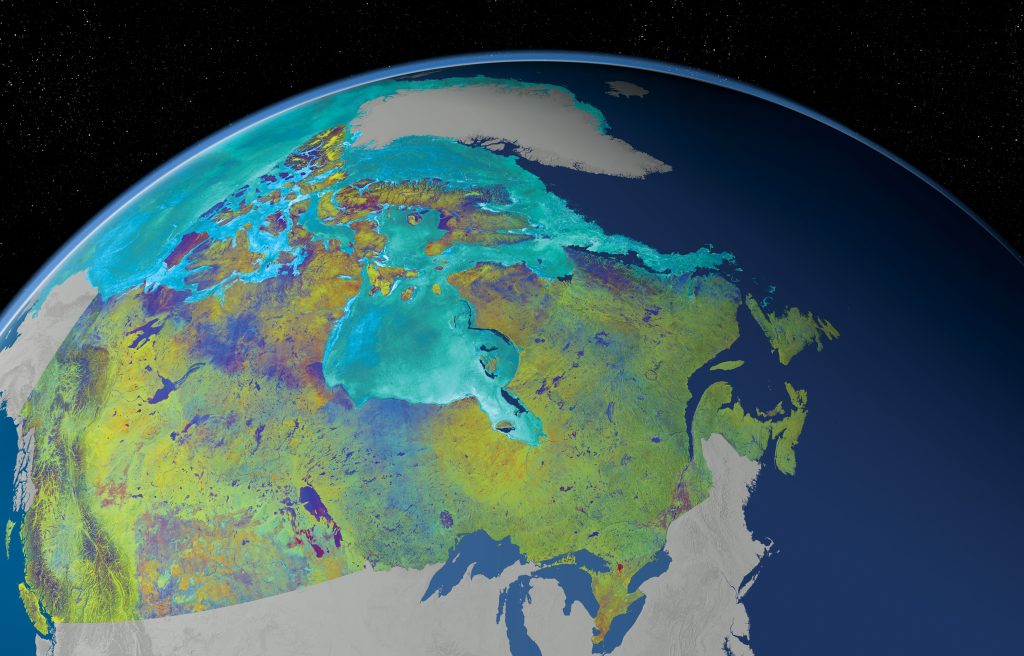
This image of Canada was made from 121 RADARSAT-2 images between May 1 and June 1, 2013. The colour variations represent changes in soil texture, roughness, and moisture levels.
Earth Missions
Hi, I’m Marley, the astronomer here at the Space Centre. Earth Day is coming up on April 22nd, and to celebrate I wanted to highlight some missions that help us to understand and better plan for the impacts of climate change.
Climate change impacts all aspects of life here on Earth, as all environments are interconnected. Scientists use orbiting satellites to study changes in Earth’s environments on a global scale and try to determine the trends due to climate change. The three missions I’m highlighting all look at the impacts of climate change in different areas: air, water and ice, and ecosystems.
Air: Measurement Of Pollution In The Troposphere (MOPITT)
MOPITT is an instrument built by the Canadian Space Agency (CSA) that is on NASA’s Terra satellite. The satellite was launched in December of 1999 to provide insight into humanity’s impact on our planet. It does this using five instruments that study different aspects of Earth: the atmosphere, ocean, land, snow and ice, and its energy budget. MOPITT focuses on the lower atmosphere or the troposphere. The troposphere is the lowest layer of the atmosphere and is where most of our weather occurs. It is impacted by climate change, as nearly all the gases and aerosols that we put into the atmosphere end up here, which can influence weather events. MOPITT looks at carbon monoxide (CO), which is a gas that comes from many human activities, including factories, cars, and forest fires. While CO itself is considered a weak greenhouse gas, it does make it more difficult for the atmosphere to get rid of other pollutants. MOPITT looks at sources and sinks, or reservoirs, of CO and how it moves through the atmosphere. MOPITT can even measure the concentration of CO down a column of the troposphere, and this helps scientists to track the CO back to its source.
Water/Ice: Surface Water and Ocean Topography (SWOT)
SWOT is an upcoming mission, scheduled to launch in November of 2022. It is led by NASA and the French space agency (National Centre for Space Studies), with contributions from the CSA and the United Kingdom Space Agency. The CSA contributed a key component of the radar instrument SWOT will use to gather data.
Its mission is to survey Earth’s surface water including details of the ocean surface and how bodies of water change over time. Climate change can affect freshwater resources, and this will impact different sectors like agriculture. The problem is that we do not have an ‘inventory’ of the amount of freshwater in lakes. We need one in order to see and assess the effects of climate change. SWOT mission goals tend to be on the local scale, especially when looking at the oceans. Often, climate impacts on the oceans are looked at globally, but there are small-scale changes that can create larger problems later. SWOT will measure ocean currents and eddies on scales as small as 20km. This will help improve computer models that use ocean data to project climate conditions.
Ecosystems: RADARSAT Constellation Mission (RCM) and RADARSAT-2
RCM and RADARSAT-2 are both Earth observing missions managed by the CSA. Both missions are particularly unique in that they can observe in any condition: clouds, smoke, even at nighttime! This is because they use Synthetic Aperture Radar (SAR). This technology uses a sensor that sends out microwaves toward Earth and then receives the signals when they are bounced back by Earth’s surface. This works at night because the detection does not rely on the light from the Sun. Additionally, microwaves are able to penetrate clouds, because microwaves are not susceptible to atmospheric scattering the way optical light is.
Launched in 2007, RADARSAT-2 has a host of abilities. It provides data about ice, hydrology (Earth’s water), agriculture, and forestry. It even assists in disaster management and response, as data are available in near real time. This can help fight against forest fires through burn mapping, which is the ability to compare burned areas to currently active fire areas to gain insight into the rate and direction the fire is moving. It is also able to easily distinguish between water and land, which can assist relief efforts in flood areas. It is even able to detect and monitor oil spills, providing insight on how to best localize cleanup efforts!
RADARSAT-2 is still in operation, but with its large host of abilities and implications, and since its images and data are used around the world, the need for a more robust system became necessary. This led to the creation of RCM, a constellation of satellites that launched in June of 2019. RCM builds on RADARSAT-2, but with three satellites it is now able to revisit parts of Canada daily while visiting the Arctic up to four times a day. In addition to this, RCM also provides access to 90% of the world each day. While having overlap with the abilities of RADARSAT-2, it expands on its ability to monitor ecosystems. This is a large task, as it includes agriculture, wetlands, forestry, and coastal change. RCM can monitor moisture levels in the top few centimeters of the soil, where crops pull their water from. These daily scans allow farmers insight into the properties of the soil and help them determine how much water and fertilizer to use. This reduces the amount of water used, as well as stops excess fertilizer from entering water systems. It still looks at forests the same way RADARSAT-2 does but looks specifically at habitat fragmentation. This is when wildlife habitat is segmented into smaller and more isolated patches, whether by urbanization or agricultural land development. RCM also focuses on preserving biodiversity by keeping an eye on coastal erosion and the impacts wetlands have on their surrounding environments.
There are more Earth observing missions, with three more NASA ones due to be launched later this year! And while satellites do a lot of work gathering data for scientists to study, you can do the same on the ground. Check out some of the following citizen science projects to see how you can help scientists learn about climate change.
Astronomer Playlist
Time
Activity
120+ min
Scientists have a lot of data to analyze, and they need citizen scientists to help them. Check out these two projects that need help with analyzing data:
NASA GLOBE CLOUD GAZE: Identify cloud types, cloud cover, and sky colour to help scientists understand the atmosphere and the changing climate.
Fossil Atmospheres: Count cells of modern and fossil leaves to help track climate change over millions of years.
Ask yourself: What questions do you have about Earth’s atmosphere? How might you find answers to your questions?
120+ min.
Scientists also need help collecting data. Check out these projects and see how you might be able to contribute to scientific discovery!
BC’s Big Nature Challenge: Observe wildlife or evidence of wildlife to help give scientists an idea about the biodiversity in our province.
FrogWatch: Frogs and toads are vulnerable to changes in the atmosphere, land and water. This means that changes in their populations can point to a larger problem not yet seen.
PlantWatch: Record flowering times for specific plant species. These dates can help scientists determine ecological changes in the environment.
WormWatch: Worms are very sensitive to changes in the soil. The number of worms (and what species they are!) in an area can tell scientists how the soil is doing. Knowing this can help scientists figure would ways to improve soil health.
Ask yourself: What do you think are some of the skills a good scientist needs to collect data in a natural environment? How might you develop those skills?

